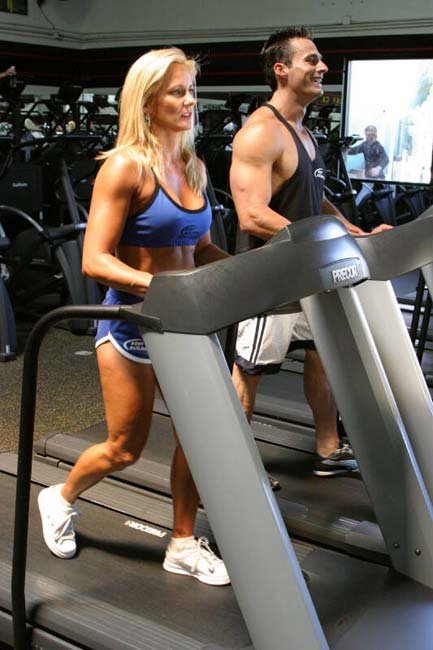Endurance, A.K.A. cardiovascular training, improves the heart's ability to pump blood and increases oxygen uptake into cells. A "fit" person can also lose more fat at rest and during exercise than an unfit person. Bodybuilders use cardiovascular training mainly as a means to increase caloric expenditure thereby increasing fat loss or decreasing fat gain.
While dieting for a bodybuilding competition, the ultimate goal is to lose body fat while maintaining the amount of muscle you have. Because your caloric intake is hypocaloric, meaning you are BURNING more calories than you are consuming, it is possible to lose muscle.
The fear of losing muscle causes many bodybuilders to be scared and confused about what type of cardio to do, when to do it, how long to do it for, along with other concerns. This article will address one strategy bodybuilders can do cardio while preparing for a competition or during any developmental stage based on both scientific literature and anecdotal feedback.
Cardiovascular Training For Bodybuilders
Low-Moderate Intensity Cardio On Weight Training Days:
As stated in the intro, bodybuilders primarily use cardio as a means in increase their caloric expenditure (Cardiovascular training has a TON of other health benefits, but we will not touch on those benefits here). The use of low-intensity cardio, done either pre or post weight training, allows one to burn more calories while not hampering recovery.
Low-intensity cardio is not as strenuous on the body as high-intensity cardio or high-intensity interval training (HIIT). It would be very hard for someone to complete a HIIT session pre weight training as it would decrease your performance when lifting weights or to complete the session post weight training as it would be very fatiguing.
We want to keep the body healthy and injury free. If you get injured then your workouts will suffer or cease altogether. Therefore, I feel it is more practical to perform low to moderate intensity cardio on weight training days. Now one could perform their cardio separate from their weight training, but for most that would mean two trips to the gym, which is impractical; Hence my recommendation to perform cardio pre or post weight training.
Whether you choose to do your cardio pre or post weight training is a personal preference. Remember, your main goal is to hit it hard in the weight room. If doing cardio pre weight training decreases your performance then it would be better for you to do it post workout. If you find that you are too tired to do cardio post weight training or simply find you become too bored and enough do not finish your cardio session, it would be better for you to do your cardio pre weight training.
High-Intensity/High-Intensity-Interval Training On Non-Weight Training Days:
High-intensity cardio stresses both the aerobic and anaerobic energy systems. The anaerobic energy system is what is stressed during weight training. Putting too much stress on the anaerobic system and hampering recovery is one reason why I do not recommend performing weight training and HIIT on the same day. Obviously running at 6 mph will burn more calories than running at 3 mph, but one has to balance their activities to allow for proper recovery.

One Has To Balance Their Activities To Allow For Proper Recovery.
There are two main types of high-intensity cardio:
- Continuous
- Interval Training
1. Continuous High-Intensity Cardio:
Continuous high-intensity cardio would be running at a high speed on the treadmill or elliptical machine for a long duration (i.e. 5+ minutes).
2. High-Intensity Interval Cardio:
Interval training involves alternating periods of work and rest (or lower levels of work). For example, running a 100 meter sprint then walking back to the start, resting, then repeating could constitute HIIT. HIIT is more intense than high-intensity continuous cardio and much more intense than low-intensity cardio.
Now it is time to create a program and to put it into action.
Weight Training & Cardio Programs
Adding Lean Mass:
The following two programs would be ideal for someone trying to add lean mass:
- Monday:
45-60 minutes Weight Training
Followed by 30 minutes Low-Intensity Cardio - Tuesday:
45-60 minutes Weight Training
Followed by 30 minutes Low-Intensity Cardio - Wednesday: OFF
- Thursday:
45-60 minutes Weight Training
Followed by 30 minutes Low-Intensity Cardio - Friday:
45-60 minutes Weight Training
Followed by 30 minutes Low-Intensity Cardio - Saturday: OFF
- Sunday: Some much needed REST!
 Click Here For A Printable Log Of Adding Lean Mass Plan 1.
Click Here For A Printable Log Of Adding Lean Mass Plan 1.
Note: As you lose weight and your fitness level improves you will most likely have to increase you duration and intensity of your cardio sessions.
OR
- Monday:
45-60 minutes Weight Training - Tuesday:
45-60 minutes Weight Training - Wednesday:
15-20 minutes of High-Intensity Cardio on the Elliptical Machine - Thursday:
45-60 minutes Weight Training - Friday:
45-60 minutes Weight Training - Saturday:
HIIT-Sprints: Ten 100 meter sprints - Sunday: Some much needed REST!
 Click Here For A Printable Log Of Adding Lean Mass Plan 2.
Click Here For A Printable Log Of Adding Lean Mass Plan 2.
Note: As you lose weight and your fitness level improves you will most likely have to increase you duration and intensity of your cardio sessions.
Losing Body Fat:
The following program could be used by someone trying to lose body fat and get RIPPED!
- Monday:
45-60 minutes Weight Training
Followed by 30 minutes Low-Intensity Cardio - Tuesday:
45-60 minutes Weight Training
Followed by 30 minutes Low-Intensity Cardio - Wednesday:
15-20 minutes of High-Intensity Cardio on the Elliptical Machine - Thursday:
45-60 minutes Weight Training
Followed by 30 minutes Low-Intensity Cardio - Friday:
45-60 minutes Weight Training
Followed by 30 minutes Low-Intensity Cardio - Saturday:
HIIT-Sprints: Ten 100 meter sprints - Sunday: Some much needed REST!!!
 Click Here For A Printable Log Of Losing Body Fat Plan.
Click Here For A Printable Log Of Losing Body Fat Plan.
Note: As you lose weight and your fitness level improves you will most likely have to increase you duration and intensity of your cardio sessions.
Conclusion
As bodybuilders, weight training is your primary concern. You do not want to do too much cardio and impair your recovery from weight training. Whether trying to gain muscle or lose fat cardio should be done. The exact amount will vary by your goal, fitness level, and ability to recover.


